2016 年广东暨南大学外国语言文学综合考试考研真题
学科、专业名称:外国语言文学、外国语言学及应用语言学
研究方向:各研究方向
考试科目名称:808 外国语言文学综合考试
考生注意:所有答案必须写在答题纸(卷)上,写在本试题上一律不给分。
I. Multiple choices. There are 20 questions in this part. Choose the best answer
to each question. Write your answers on the ANSWER SHEET. Both literature candidates
and linguistics candidates must do this part. (20%)
1. Britain is separated from the rest of Europe by the English Channel in the
________ and the North Sea in the ________.
A. east; north
B. south; north
C. southeast; northeast
D. south; east
2. Which of the following does NOT belong to the British Parliament in the full
sense?
A. The House of Commons
C. Senate
B. The House of Lords
D. Sovereign
3. Students who pass the exam of “the 11 plus” in Britain can go to ________.
A. grammar schools
C. public schools
B. comprehensive schools
D. technical schools
4. The Falkland Islands War was between Britain and ________.
A. France
C. Argentina
B. New Zealand
D. Australia
5. The Open University in UK does not offer degrees and other courses for adult
students from _______.
A. America
B. Belgium
C. France
D. Germany
6. ________ has earned the name of “Cottonpolis”.
A. Birmingham
C. Edinburgh
�
B. Cardiff
D. Manchester
7. The famous Silicon Valley is in the state of ________.
A. California
B. Idaho
C. Illinois
D. Texas
8. The economic problem caused by the depression in 1929 was eventually solved by
________.
A. the New Deal
C. technological changes
B. new energy sources
D. World War II
9. ________ is often used to refer to the U.S. Department of Defense.
A. Capitol Hill
C. The Pentagon
B. The Empire State Building
D. The White House
10. The First Continental Congress was held in 1774 in ________.
A. Louisiana
B. New York
C. Philadelphia
D. Washington
11. The Expenditure in American public schools is guided or directed by ________.
A. boards of education
B. headmaster
C. students
D. teachers
12. The invention of ________ marked the beginning of “ the Age of Visual
Information”.
A. computer
B. newspaper
C. telegraph
D. television
13. Detroit is famous for the production of ________.
A. automobile
B. bamboo
C. steel
D. timber
14. Admission to a university is determined by ________ in the United States.
A. each university
C. students’ points
B. education board
D. the secondary school
15. The European discovery of Canada can be traced back to the end of ______.
A. 12th century
C. 14th century
B. 13th century
D. 15th century
�
16. In Canada, the term of the Governor General is ________ years.
A. three
B. four
C. five
D. six
17. ________ claimed that Australia and New Zealand belonged to Britain in 1770.
A. Abel Tasman
C. Christopher Columbus
B. Amerigo Vespucci
D. James Cook
18. In Australia, the Constitution can be changed only by ________.
A. referendum
B. British Queen
C. the Prime Minister
D. the Supreme Court
19. Which city is known as “city of sails” in New Zealand?
A. Auckland
B. Christchurch
C. Dunedin
D. Wellington
20. The population of Ireland is predominantly of ________ origin.
A. English
B. Celtic
C. Norman
D. French
II. Fill in the blanks with proper answers. Write your answers on the ANSWER SHEET.
Both literature candidates and linguistics candidates must do this part. (20%)
1. Chomsky’s ________ Hypothesis states that children are born with a language
acquisition device, a unique kind of knowledge that fits them for language
learning.
2. Speech organs, also known as vocal organs, are those parts of the human body
involved in the ________ of speech.
3. The word distemperedhas three morphemes, namely, dis-, temper, and -ed, of which
temper is a ________ morpheme, while dis- and -ed are ________ morphemes.
4. The borrowing of ________ is a process in which both form and meaning are borrowed
with only a slight change to the phonological system of the new language.
5. ________, together with openness, is generally regarded as the core of creativity
of language.
�
6. Propositional logic studies the ________ for propositions, while predicate logic
studies the ________ of simple propositions.
7. From a psycholinguistic point of view, we store a great deal of information about
the properties of words in our ________, and retrieve this information when we
understand language.
8. Mark Johnson (1987) defines a(n) ________ as a recurring, dynamic pattern of
our perceptual interactions and motor programs that gives coherence and
structure to our experiences.
9. The 1970s witnessed a change in language teaching when Hyme’s theory of ________
was introduced into the field.
10. In saying “Morning!” the speaker intends to perform a(n) ________ act of
greeting.
11. It was in 1798, with the publication of William Wordsworth’s ________, in
collaboration with S.T. Coleridge, that romanticism began to bloom and found
a firm place in the history of English literature.
12. The typical feature of Robert Browning's poetry is the ________.
13. As one of the great innovators of the modern novel, Virginia Woolf developed
the technique of ________ in her writing, which focuses on the complex lives
of characters’ inner minds instead of outward actions.
14. Thomas Gray’s ________ is regarded to be the most representative works of
Graveyard school.
15. The English sonnet, also known as Shakespearean sonnet, usually has a regular
rhyme scheme of ________.
16. Walt Whitman was a pioneering figure of American poetry. His innovation first
of all lies in his use of ________.
17. ________ is a current of literary theory that dominated Anglo-American literary
criticism in the middle decades of the 20th century. It emphasizes close reading,
to discover how a work of literature functioned as a self-contained,
self-referential aesthetic object.
18. ________ established himself as the spokesman for the school of "Art for art's
�
sake", which affirmed that art was valuable as art, that artistic pursuits were
their own justification and that art did not need moral justification.
19. J. Alfred Prufrock is a representative character in ________’s poem which deals
with spiritually exhausted people and captures their sense of defeat for failing
to act courageously.
20. In 1925, Fitzgerald wrote his best novel ________. It is a story of an idealist
who was destroyed by the influence of the wealthy, pleasure-seeking people around
him.
III. Write your answers on the ANSWER SHEET according to requirements. Both
literature candidates and linguistics candidates must do this part. (10%)
Section A: Decide whether each of the following statements is True or False. If
it is true, write T on the ANSWER SHEET. If it is false, write F on the ANSWER SHEET.
1. According to Chomsky, a universal grammar is a theory for studying the initial
states, and particular grammars are theories for studying the states of
acquisition.
2. The weak version of the Sapir-Whorf hypothesis claims that language plays a
decisive role in shaping our ways of thinking.
3. Linguistically, names for superordinate categories are often mass nouns when
basic level terms are count names.
4. In English, the“ch[t
]”of churchand the“j[d
]”of jetare both fricatives.
5. In literary texts, the grammatical system of language is often exploited,
experimented with, or made to deviate from other, more everyday, forms of
language.
Section B: Identify the author and indicate the genre of each of the following works.
1. Oliver Twist
�
2. Mrs Warren’s Profession
3. “To My Coy Mistress”
4. The Grapes of Wrath
5. The Hairy Ape
IV. Choose SIX terms from the following and explain them briefly. Write your answers
on the ANSWER SHEET. (30%)
1. The IPA
2. Back-formation
3. Semantic Triangle
4. Construal
5. Performatives
6. Error Analysis
7. Byronic Hero
8. Critical Realism
9. Metaphor
10. Imagist Movement
11. The Beat Generation
12. Black Humor
V. Answer the following questions. According to different majors, choose the ones
you must do. Write your answers on the ANSWER SHEET. (40%)
Section A (for linguistics candidates only):
1. What is the relationship between arbitrariness and convention?
�
2. Give a componential analysis of such words as father, mother, sonand daughter.
3. Analyze the following short dialog using Grice’s Cooperative Principle.
A: Where is John?
B: He’s gone to the library. He said so when he left.
4. Analyze the structural ambiguity in the following sentence by drawing tree
diagrams.
The children watched the firework from the hill.
Section B (for literature candidates only ):
1. What do you think of the setting of “Break, Break, Break”? Discuss what you
consider to be the poem’s central points.
2. Based on Mrs. Dalloway, discuss Virginia Woolf’s writing techniques.
3. Based on Theodore Dreiser’s Sister Carrie, discuss the typical features of
American Naturalism.
4. In what sense is William Faulkner regarded as one of the representative writers
ofdepicting the South?
VI. Choose ONE of the following and write your answer on the ANSWER SHEET. (30%)
1. Task-Based Language Teaching (TBLT) is now a popular teaching approach among
language researchers. State your own opinion about TBLT (including its
advantages and disadvantages) using your linguistic knowledge. (for linguistics
candidates only)
2. Analyze the following poem as to its theme, poetic form, and rhetorical devices,
and develop it into an essay of 200 words (for literature candidates only).
……
Because I could not stop for Death
Emily Dickinson
�
Because I could not stop for Death,
He kindly stopped for me;
The carriage held but just ourselves
And Immortality.
We slowly drove, he knew no haste,
And I had put away
My labor, and my leisure too,
For his civility.
We passed the school, where children strove
At recess, in the ring;
We passed the fields of gazing grain,
We passed the setting sun.
Or rather, he passed us;
The dews grew quivering and chill,
For only gossamer my gown,
My tippet only tulle.
We paused before a house that seemed
A swelling of the ground;
The roof was scarcely visible,
The cornice but a mound.
�
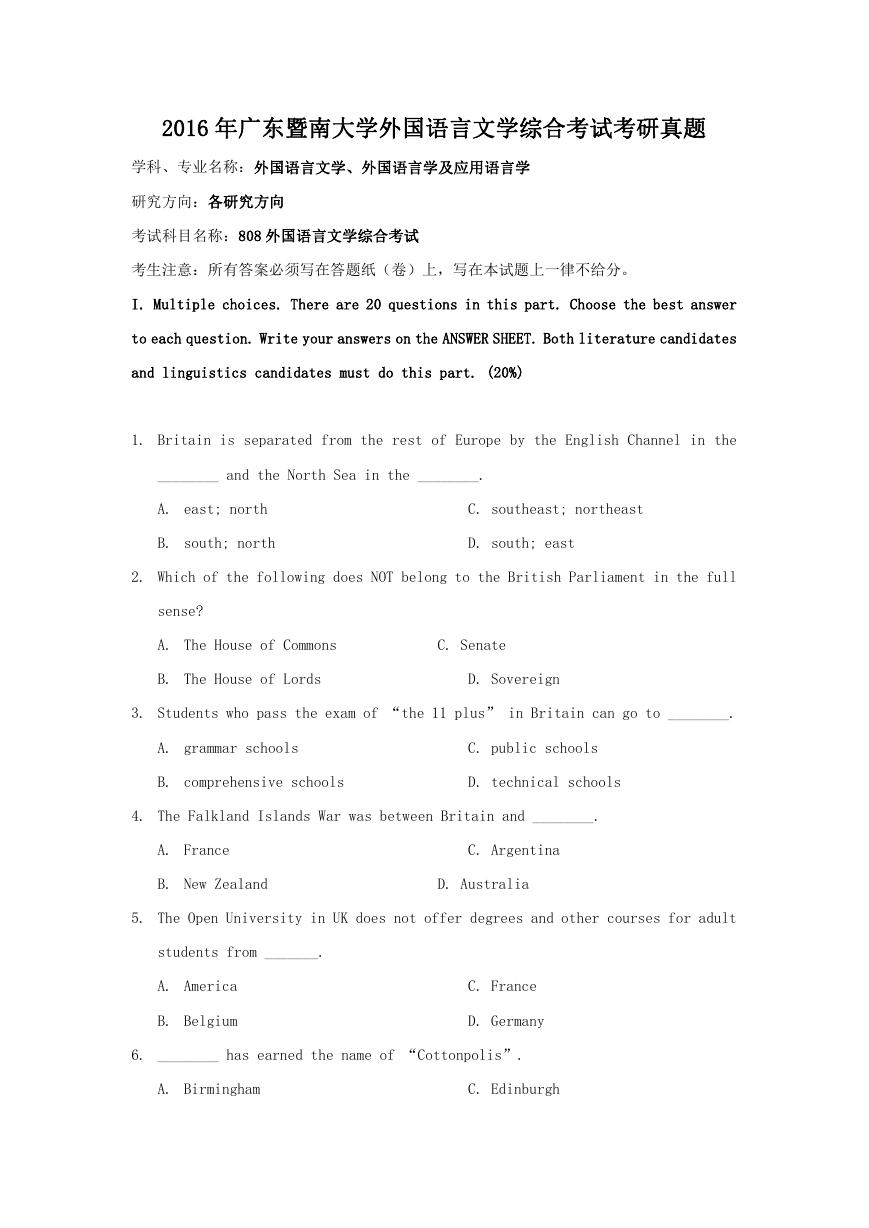

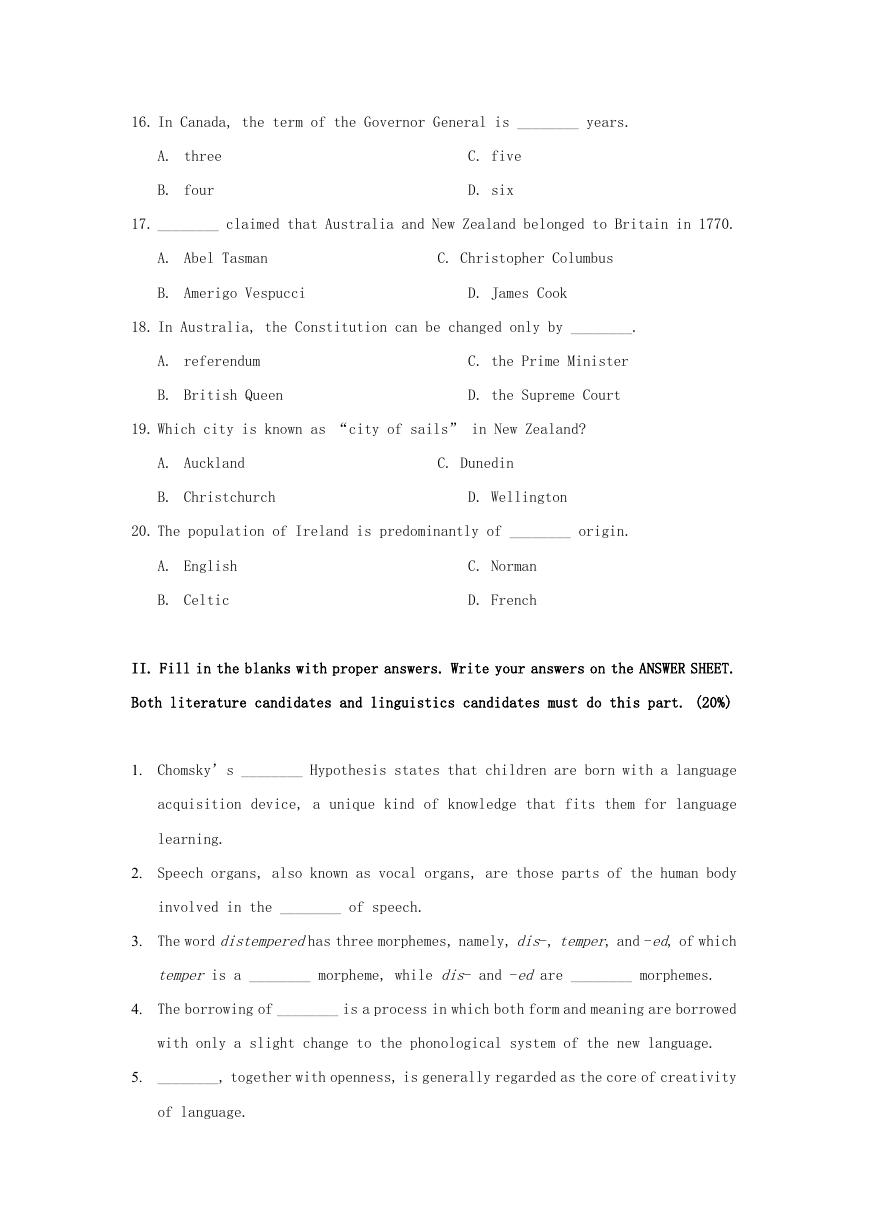
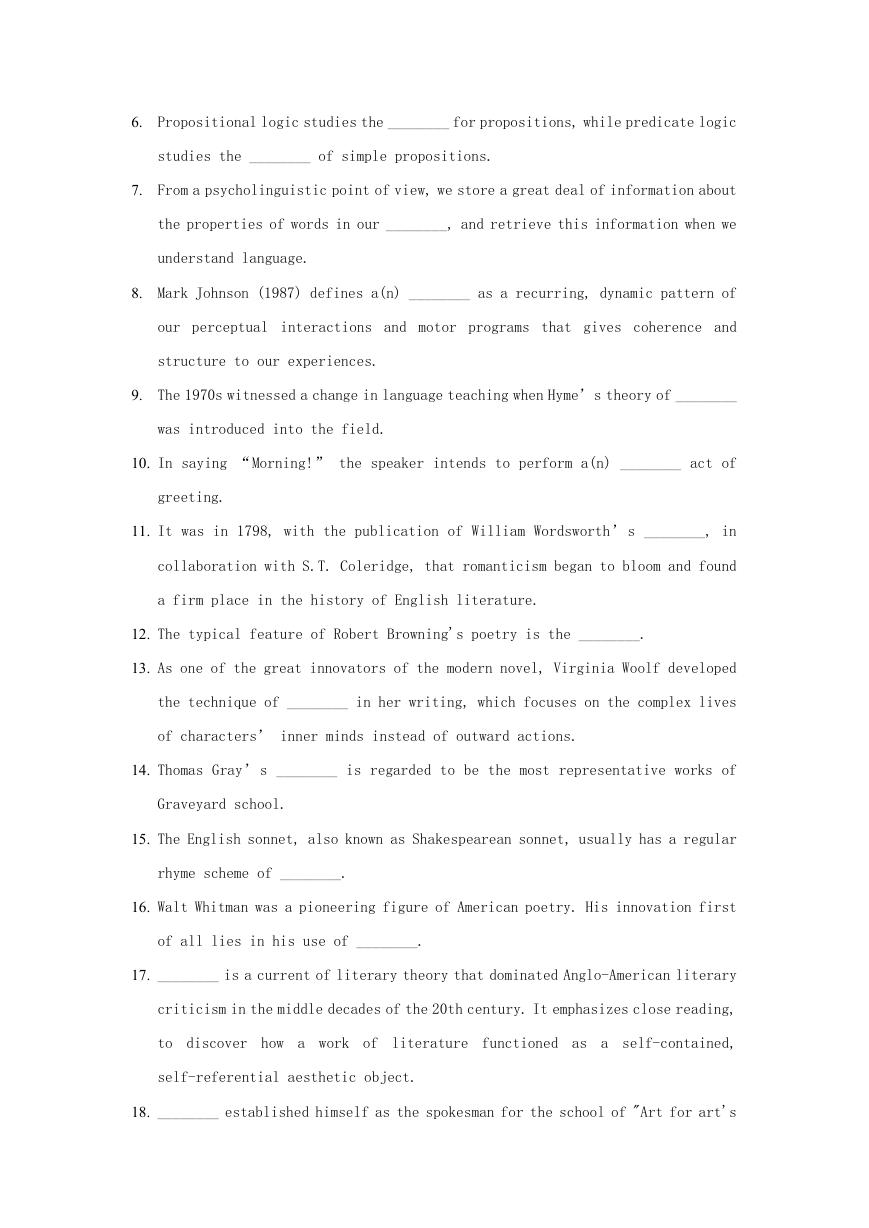
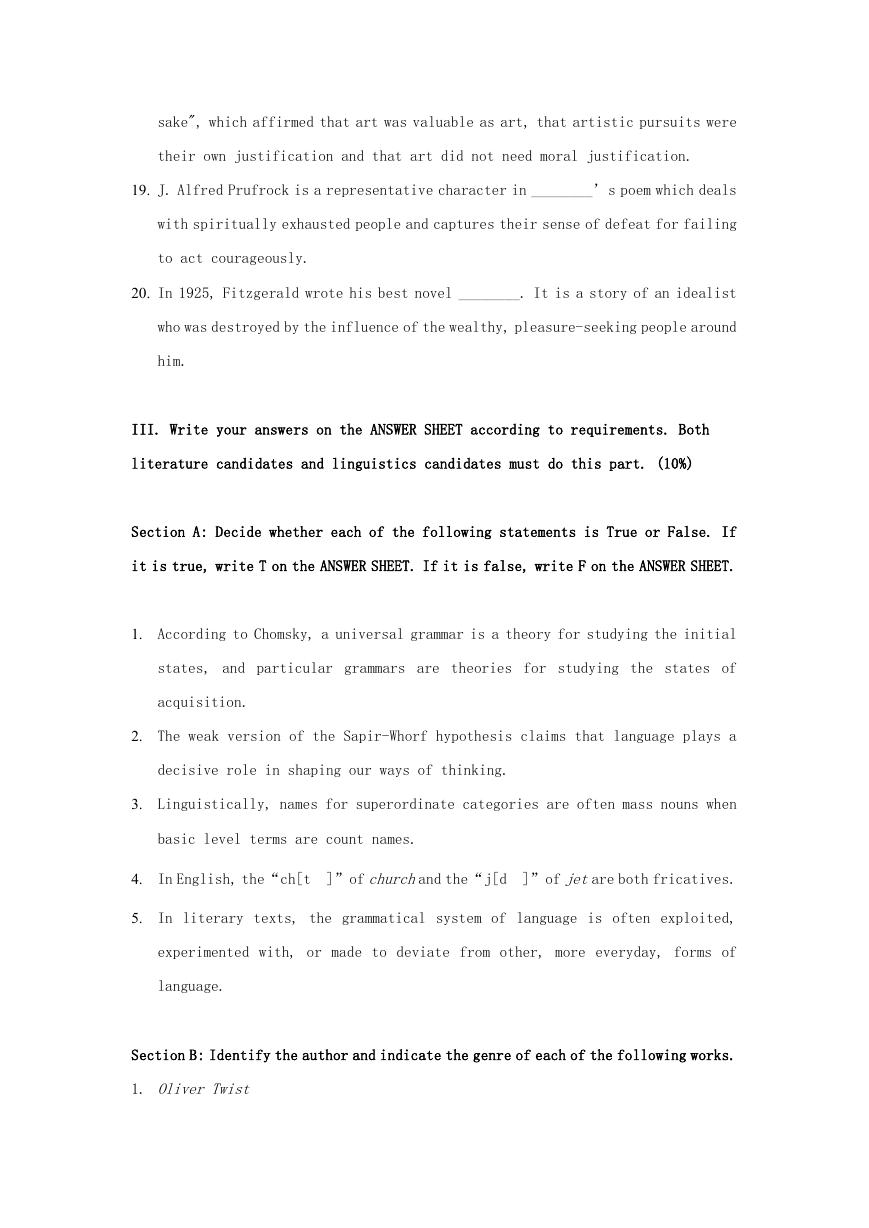
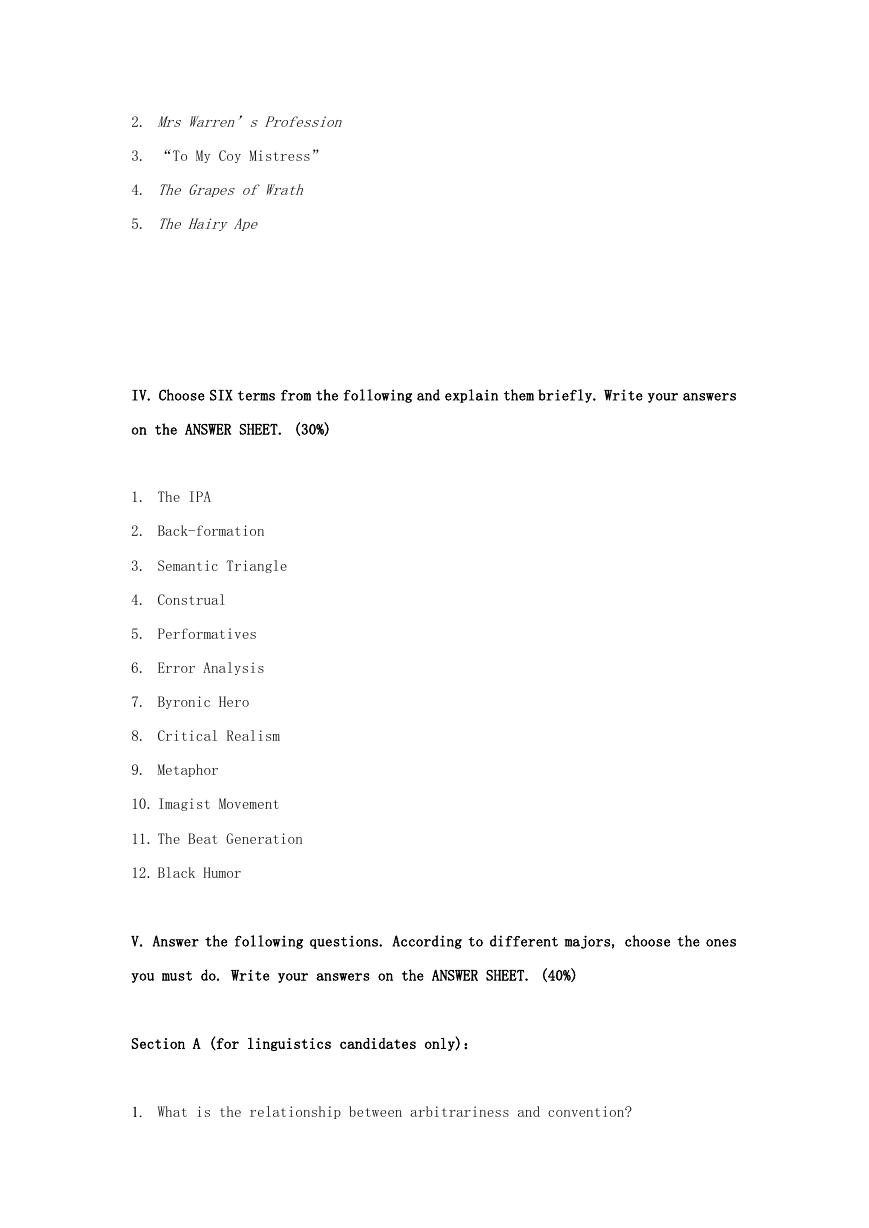
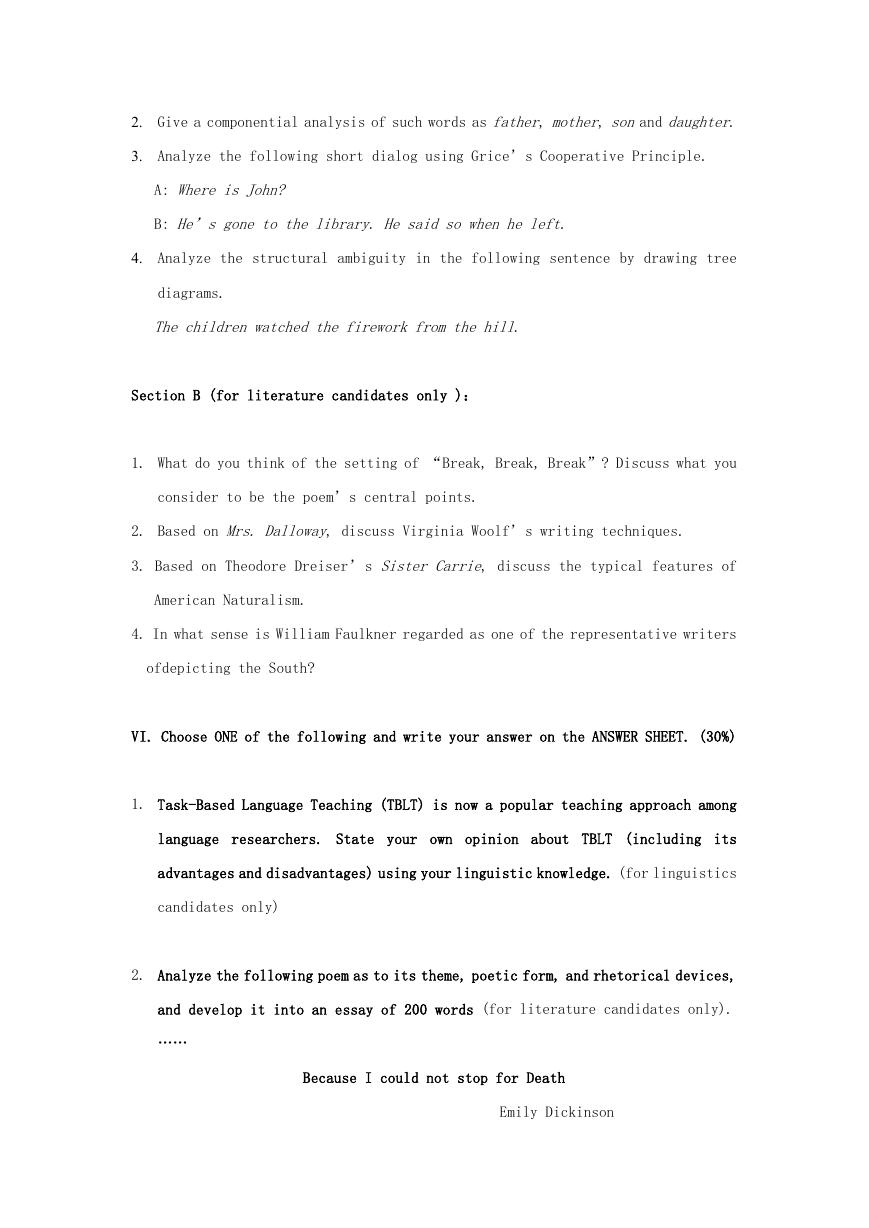
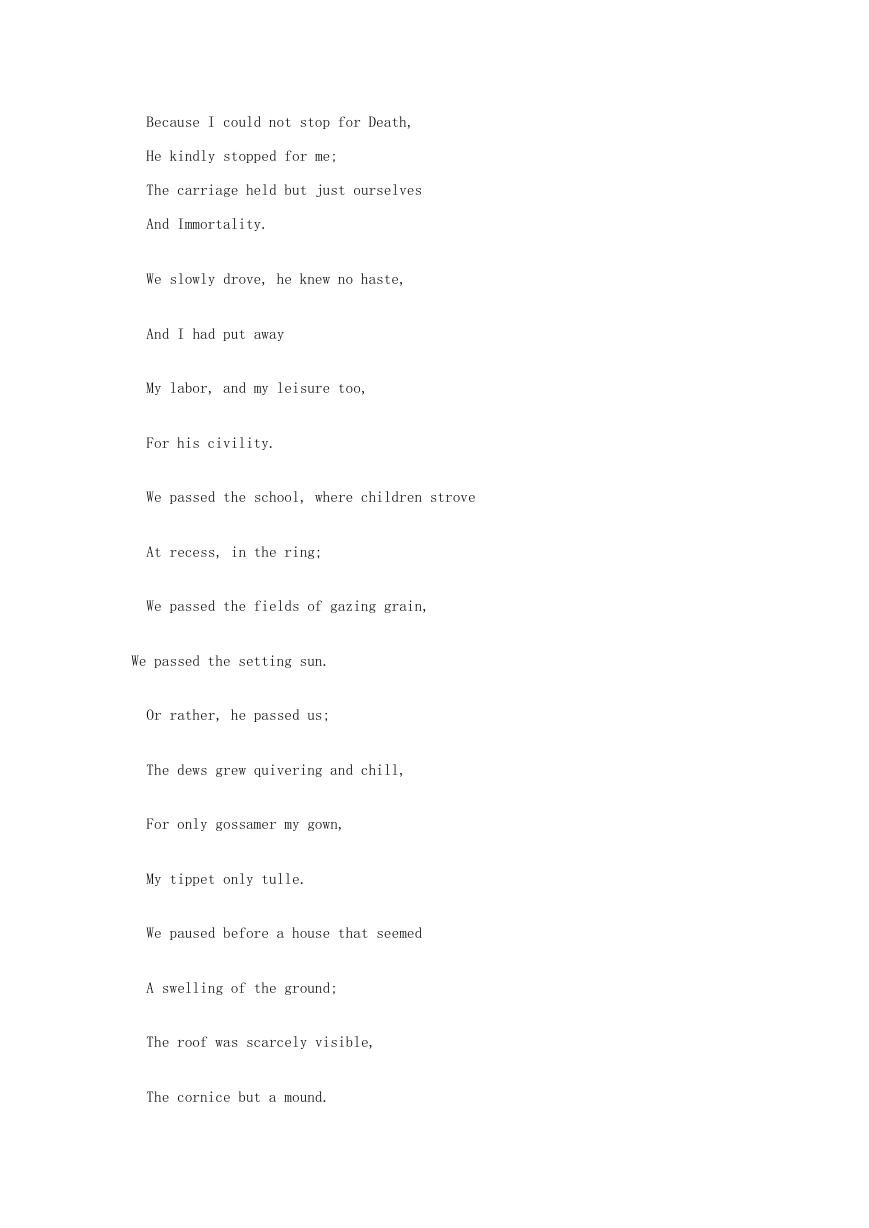








 2023年江西萍乡中考道德与法治真题及答案.doc
2023年江西萍乡中考道德与法治真题及答案.doc 2012年重庆南川中考生物真题及答案.doc
2012年重庆南川中考生物真题及答案.doc 2013年江西师范大学地理学综合及文艺理论基础考研真题.doc
2013年江西师范大学地理学综合及文艺理论基础考研真题.doc 2020年四川甘孜小升初语文真题及答案I卷.doc
2020年四川甘孜小升初语文真题及答案I卷.doc 2020年注册岩土工程师专业基础考试真题及答案.doc
2020年注册岩土工程师专业基础考试真题及答案.doc 2023-2024学年福建省厦门市九年级上学期数学月考试题及答案.doc
2023-2024学年福建省厦门市九年级上学期数学月考试题及答案.doc 2021-2022学年辽宁省沈阳市大东区九年级上学期语文期末试题及答案.doc
2021-2022学年辽宁省沈阳市大东区九年级上学期语文期末试题及答案.doc 2022-2023学年北京东城区初三第一学期物理期末试卷及答案.doc
2022-2023学年北京东城区初三第一学期物理期末试卷及答案.doc 2018上半年江西教师资格初中地理学科知识与教学能力真题及答案.doc
2018上半年江西教师资格初中地理学科知识与教学能力真题及答案.doc 2012年河北国家公务员申论考试真题及答案-省级.doc
2012年河北国家公务员申论考试真题及答案-省级.doc 2020-2021学年江苏省扬州市江都区邵樊片九年级上学期数学第一次质量检测试题及答案.doc
2020-2021学年江苏省扬州市江都区邵樊片九年级上学期数学第一次质量检测试题及答案.doc 2022下半年黑龙江教师资格证中学综合素质真题及答案.doc
2022下半年黑龙江教师资格证中学综合素质真题及答案.doc